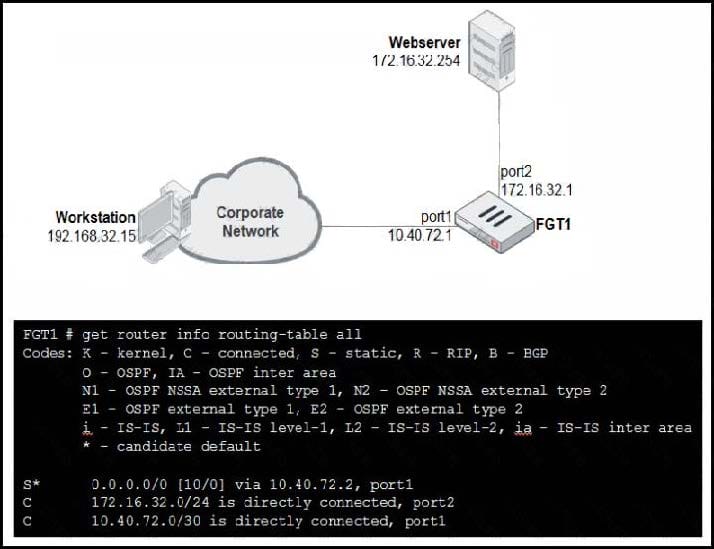Exam Details
Exam Code
:NSE4_FGT-5.6Exam Name
:Fortinet NSE 4 - FortiOS 5.6Certification
:Fortinet CertificationsVendor
:FortinetTotal Questions
:114 Q&AsLast Updated
:Jul 10, 2025
Fortinet Fortinet Certifications NSE4_FGT-5.6 Questions & Answers
-
Question 51:
View the exhibit. A user at 192.168.32.15 is trying to access the web server at 172.16.32.254.

Which of the following statements best describes how the FortiGate will perform reverse path forwarding
(RPF) checks on this traffic?
(Choose two.)
Response:
A. Loose RPF check will deny the traffic.
B. Strict RPF check will allow the traffic.
C. Strict RPF check will deny the traffic.
D. Loose RPF check will allow the traffic.
-
Question 52:
A remote user is trying to authenticate with a user name and password. How does FortiGate verify the login credentials? Response:
A. FortiGate queries its own database for user credentials.
B. FortiGate queries the remote server for user credentials.
C. FortiGate sends the user entered credentials to the remote server for verification.
D. FortiGate re-generates the algorithm based on the login credentials and compares it against the algorithm stored on the remote server.
-
Question 53:
Examine the log message attributes. Which statements are correct?
(Choose two.)
hostname=www.youtube.com profiletype="Webfilter_Profile"
profile="default"
status="passthrough"
msg="URL belongs to a category with warnings enabled"
Response:
A. The website was allowed on the first attempt
B. The user failed authentication
C. The category action was set to warning.
D. The user was prompted whether to proceed or go back.
-
Question 54:
Examine this FortiGate configuration: config system global set av-failopen pass set fail-open disable end Examine the output of the following debug command: # diagnose hardware sysinfo conserve memory conserve mode: on total RAM: 3040 MB memory used: 2706 MB 89% of total RAM memory used threshold extreme: 2887 MB 95% of total RAM memory used threshold red: 2675 MB 88% of total RAM memory used threshold green: 2492 MB 82% of total RAM Based on the diagnostics outputs above, how is the FortiGate handling packets that require IPS
inspection? Response:
A. They are dropped.
B. They are allowed and inspected.
C. They are allowed, but with no inspection.
D. They are allowed and inspected as long as no additional proxy-based inspection is required.
-
Question 55:
An administrator observes that the port1 interface cannot be configured with an IP address. What can be
the reasons for that?
(Choose three.)
Response:
A. The interface has been configured for one-arm sniffer.
B. The interface is a member of a virtual wire pair.
C. The operation mode is transparent.
D. The interface is a member of a zone.
E. Captive portal is enabled in the interface.
-
Question 56:
Which file names will match the *.tiff file name pattern configured in a DLP filter?
(Choose two.)
Response:
A. tiff.jpeg
B. tiff.tiff
C. gif.tiff
D. tiff.png
-
Question 57:
When using firewall policy NAT, which statements are true regarding virtual IP (VIP)?
(Choose two.)
Response:
A. The default type is static NAT, which applies one-to-one mappings for incoming and outgoing connections.
B. The static NAT VIP can be restricted to forward only certain ports.
C. FortiGate does not respond to ARP requests for VIP, as ARP responses are non configurable for VIP.
D. The VIP is selected in the firewall policy source address field.
-
Question 58:
View the exhibit.

The client cannot connect to the HTTP web server. The administrator run the FortiGate built-in sniffer and
got the following output:
What should be done next to troubleshoot the problem?
Response:
A. Execute another sniffer in the FortiGate, this time with the filter "host 10.0.1.10".
B. Run a sniffer in the web server.
C. Capture the traffic using an external sniffer connected to port1.
D. Execute a debug flow.
-
Question 59:
What is eXtended Authentication (XAuth)? Response:
A. It is an IPsec extension that forces remote VPN users to authenticate using their credentials (user name and password).
B. It is an IPsec extension that authenticates remote VPN peers using digital certificates.
C. It is an IPsec extension that forces remote VPN users to authenticate using their local ID.
D. It is an IPsec extension that authenticates remote VPN peers using a preshared key.
-
Question 60:
Which of the following statements is true regarding the configuration settings? Response:
A. When a remote user accesses https://10.200.1.1:443, the FortiGate login page appears.
B. When a remote user accesses https://10.200.1.1:443, the FortiGate login page appears.
C. When a remote user accesses http: //10.200.1.1 :443, the FortiGate login page appears.
D. When a remote user accesses http: /110.200.1.1:443, the SSL VPN login page appears.
E. The settings are invalid. The administrator settings and the SSL VPN settings cannot use the same port.
Related Exams:
FCP_FAZ_AD-7.4
FCP - FortiAnalyzer 7.4 AdministratorFCP_FGT_AD-7.4
FCP - FortiGate 7.4 AdministratorFCP_FGT_AD-7.6
FortiGate 7.6 Administrator FCP_FGT_AD-7.6FCP_WCS_AD-7.4
FCP - AWS Cloud Security 7.4 AdministratorFCSS_EFW_AD-7.4
FCSS - Enterprise Firewall 7.4 AdministratorFCSS_NST_SE-7.4
FCSS - Network Security 7.4 Support EngineerFCSS_SASE_AD-24
FCSS - FortiSASE 24 AdministratorNSE4_FGT-5.6
Fortinet NSE 4 - FortiOS 5.6NSE4_FGT-6.0
Fortinet NSE 4 - FortiOS 6.0NSE4_FGT-6.4
Fortinet NSE 4 - FortiOS 6.4
Tips on How to Prepare for the Exams
Nowadays, the certification exams become more and more important and required by more and more enterprises when applying for a job. But how to prepare for the exam effectively? How to prepare for the exam in a short time with less efforts? How to get a ideal result and how to find the most reliable resources? Here on Vcedump.com, you will find all the answers. Vcedump.com provide not only Fortinet exam questions, answers and explanations but also complete assistance on your exam preparation and certification application. If you are confused on your NSE4_FGT-5.6 exam preparations and Fortinet certification application, do not hesitate to visit our Vcedump.com to find your solutions here.